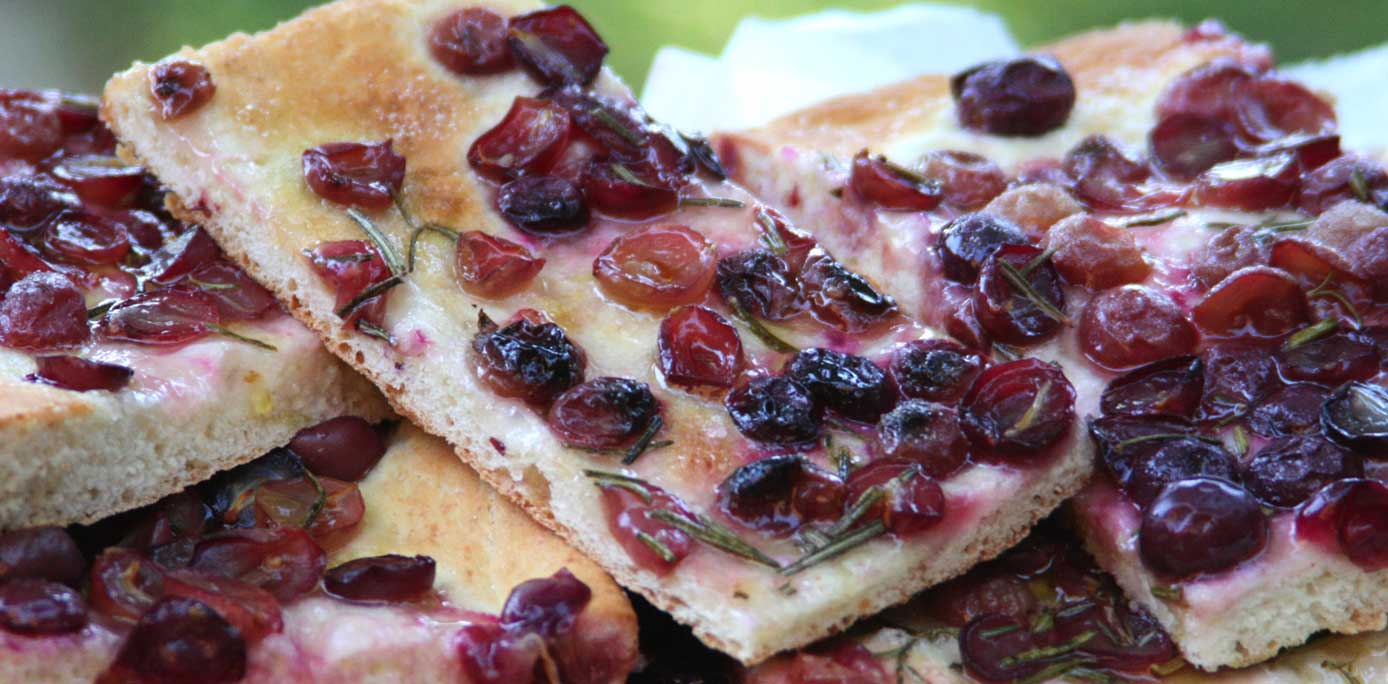If there is one reason to be be excited that summer is ending, it’s the appearance of freshly baked schiacciata con l’uva in the windows of local bakeries in Tuscany. If you have visited Florence or the Chianti area of Tuscany in autumn, you may have seen schiacciata con l’uva for sale, and if you were clever, you would have bought some and eaten it all without sharing! It is typically found in Florence and Prato, but it’s also popular in other cities throughout Tuscany. Schiacciata con l’uva has ancient origins that date back to the Etruscan era. Thankfully, the recipe was handed down, its tradition continued over the centuries and today it is a dish that can’t be missed during the harvest, a ritual much felt in Tuscany.
Schiacciata con l’uva is one of those wonderful Italian delights you must wait a whole year to enjoy. I actually love the fact that many traditional Italian sweets are not available year round: it makes them more special, and definitely more appreciated.
The word “schiacciata” usually refers to a flat focaccia bread and “uva” are grapes, so schiacciata con l’uva is a wine-grape bread, traditionally made in Tuscany during the autumn vendemmia – when the grapes are being harvested. It’s precisely because the grape is the protagonist of this dessert that schiacciata is prepared during the months of September and October, those dedicated to the harvest. It is a poor dish and its preparation requires a few simple ingredients: bread dough, olive oil, sugar, and black grapes.
During the vendemmia, grapes are very sweet and the best – or most traditional – grapes to use are local Tuscan wine grapes, Canaiolo. The canaiola grape is characterized by its natural sweetness, which gives schiacciata an unmistakable softness, and a sweet wine-like flavor. In the original version, it is absolutely forbidden to remove the seeds from the grapes, as their “crunch” when eating schiacciata is one of the dish’s characteristics.
I usually use American concord or muscat grapes, which are called uva fragola in Italian (strawberry grapes). They are also seasonal and, now that I don’t live in Tuscany anymore, are easier to find in the markets here in Rome. They are small, black grapes and, when you put them in your mouth, the skin pops open and the sweetest, most delicious pulp jumps out. Although it goes against tradition, you can cut the grapes in a half and remove the seeds if you prefer not to eat them. A little tedious, but a good job to do while waiting for the dough to rise, and well worth it to avoid spitting them out later on.
The first time I made schiacciata con l’uva I used a double layer of dough and grapes (as per the recipe), but I then decided I would prefer a thinner, flatter version, so I made it with just one layer. I recommend to bake this on a flat oven tray, without worrying about confining it into a cake tin, otherwise it really will resemble more of a cake than a schiacciata – Yummy nonetheless, but I’ll leave it up to you to decide how you prefer it.
Schiacciata con l’uva
■ 400 g plain flour
■ 21 g dry yeast (brewer’s yeast)
■ 250 ml warm water
■ 250 g sugar (you may not use it all)
■ 1 kg black wine grapes
■ 2 tablespoons extra virgin olive oil
■ pinch of salt
■ fresh rosemary, chopped roughly (optional)
DIRECTIONS
1. Place the flour into a bowl, add the yeast, 2 tablespoons of sugar, salt, olive oil and about half the water. Knead, adding water as required until the dough is compact and comes away from the edges of the bowl. Remove the dough from the bowl and continue kneading on a lightly floured board for 5-10 minutes, until the dough is smooth.
2. Place the dough into a bowl lightly greased with olive oil and cover with a clean tea-towel. Allow it to rise for at least 1 hour.
3. When the dough has doubled in volume, put it back on the floured surface, add 50 g of sugar, 4 tablespoons of oil and work it again for about 5 minutes. Wash the grapes, and remove all the seeds if necessary. (You can cut grapes in half and, although this is a personal choice, you will see in the pictures where I did it, and where the grapes were left whole).
4. Divide the dough into two equal parts and, with the help of a rolling pin, roll it out until it is 1 cm thick.
5. Oil a baking dish, roll out one part of the dough and cover it with half of the grapes, a tablespoon of sugar and two tablespoons of olive oil.
6. Cover with the remaining dough, press down lightly and you will feel some of the grapes popping under your hands.
7. Arrange remaining grapes on top, sprinkle with sugar and two more tablespoons of oil. Use a pastry brush to ensure the border is coated with olive oil.
8. You might want to add some fresh rosemary on top too, although it is optional.
9. Bake for 50-60 minutes in a preheated oven.
*A single layer schiacciata can go into the oven for about 15-20min or until the edges are golden brown.
Se c’è un motivo per essere contenti che l’estate sta finendo, è la Schiacciata con l’uva appena sfornata che compare nelle vetrine delle pasticcerie toscane. Se avete visitato Firenze o il Chianti della Toscana, in autunno, avrete visto in vendita la Schiacciata con l’uva, e se siete stati furbi, ne avrete comprato un po’ e l’avrete mangiata tutta senza condividerla! Si trova in genere a Firenze e Prato, ma è popolare anche in altre città della Toscana.
La Schiacciata con l’uva ha origini antiche che risalgono all’epoca etrusca. Per fortuna, la ricetta è stata tramandata, la sua tradizione ha continuato nel corso dei secoli e oggi è un dolce che non può mancare durante la vendemmia, un rito molto sentito in Toscana.
La Schiacciata con l’uva è una di quelle meravigliose delizie italiane che dovete aspettare un anno intero per godervela. Adoro il fatto che molti dolci tradizionali italiani non siano disponibili tutto l’anno: li rende più speciali e sicuramente più apprezzati.
La parola “schiacciata” di solito si riferisce a una focaccia piatta, così Schiacciata con l’uva è un pane con uva da vino, tradizionalmente fatto in Toscana durante la vendemmia autunnale quando le uve vengono raccolte. E’ proprio perché l’uva è la protagonista di questo dolce che esso viene preparato durante i mesi di settembre e ottobre, dedicati alla vendemmia. E’ una preparazione povera e richiede pochi ingredienti semplici: pasta per il pane, olio d’oliva, zucchero e uva nera. Durante la vendemmia, le uve sono molto dolci e le migliori – o le più tradizionali – da utilizzare sono le uve toscane locali, quelle di Canaiolo. L’uva Canaiola si caratterizza per la sua naturale dolcezza, che conferisce alla Schiacciata un’inconfondibile morbidezza e un sapore dolce e vinoso. Nella versione originale, è assolutamente vietato rimuovere i semi dai chicchi, poiché il loro “croccare”, quando si mangia la Schiacciata, è una delle caratteristiche del dolce.
Di solito uso l’uva concord americana o l’uva moscato, che si chiama anche uva fragola. Sono uve stagionali e, ora che non vivo più in Toscana, sono più facili da trovare nei mercati qui a Roma. Sono piccole uve nere e, quando le metti in bocca, la pelle si apre e la polpa più dolce e deliziosa salta fuori. Anche se va contro la tradizione, potete tagliare le uve a metà e togliere i semi se preferite non mangiarli. Un po’ noioso, ma è un buon lavoro da fare mentre si attende che l’impasto cresca, e ne vale la pena per evitare di sputarli in seguito.
La prima volta che ho fatto la Schiacciata con l’uva ho usato un doppio strato di pasta e uva (come da ricetta), ma poi ho deciso che avrei preferito una versione più sottile e piatta, quindi l’ho fatta con un solo strato. Consiglio di infornare su una teglia da forno piatta, senza doversi preoccupare di fare una torta, altrimenti assomiglierà più a una torta – buona comunque – che non a una Schiacciata, ma lascerò decidere a voi come la preferite.
Schiacciata con l’uva
■ 400 g di farina semplice
■ 21 g di lievito secco (lievito di birra)
■ 250 ml di acqua calda
■ 250 g di zucchero (si può non usare tutto)
■ 1 kg di uva da vino nera
■ 2 cucchiai di olio d’oliva extra vergine
■ un pizzico di sale
■ rosmarino fresco tritato grossolanamente (facoltativo)
ISTRUZIONI
1. Mettere la farina in una ciotola, aggiungere il lievito, 2 cucchiai di zucchero, sale, olio d’oliva e circa metà dell’acqua. Impastare, aggiungendo acqua secondo necessità fino a quando l’impasto non è compatto e si stacca dai bordi della ciotola. Togliere l’impasto dalla ciotola e continuare a impastare su una superficie leggermente infarinata per 5-10 minuti, fino a quando l’impasto non sarà liscio.
2. Mettere l’impasto in una terrina leggermente unta con olio d’oliva e coprire con un canovaccio pulito. Lasciare lievitare per almeno 1 ora.
3. Quando l’impasto ha raddoppiato il volume, rimettetelo sulla superficie infarinata, aggiungere 50 g di zucchero, 4 cucchiai di olio e lavorare di nuovo per circa 5 minuti. Lavare l’uva e rimuovere tutti i semi se necessario. (Anche se questa è una scelta personale, potete tagliare le uve a metà. Vedrete nelle foto dove l’ho fatto e dove sono stati lasciati i chicchi interi).
4. Dividere l’impasto in due parti uguali e, con l’aiuto di un mattarello, stenderlo fino a ottenere uno spessore di 1 cm.
5. Ungere una teglia, stendere una parte dell’impasto e coprirlo con metà dell’uva, un cucchiaio di zucchero e due cucchiai di olio d’oliva.
6. Coprire con l’impasto rimasto, premere leggermente e sentirete un po’ dell’uva che scoppierà sotto le mani.
7. Disporre le rimanenti uve in cima, cospargere di zucchero e altri due cucchiai di olio. Utilizzare un pennello da cucina per garantire che il bordo sia rivestito con olio d’oliva.
8. Potreste anche aggiungere del rosmarino fresco sopra, sebbene sia facoltativo.
9. Cuocere per 50-60 minuti in forno prriscaldato.
* Una Schiacciata a un solo strato sta in forno per circa 15-20 minuti o fino a quando i bordi non saranno dorati.































